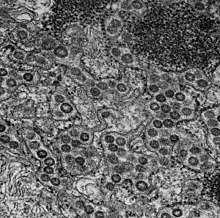
MRC-5 (Medical Research Council cell strain 5) is a diploid cell culture line composed of fibroblasts, originally developed from the lung tissue of a 14-week-old aborted Caucasian male fetus.[1][2] The cell line was isolated by J.P. Jacobs and colleagues in September 1966 from the seventh population doubling of the original strain, and MRC-5 cells themselves are known to reach senescence in around 45 population doublings.[2][3][4]
Applications
[edit]MRC-5 cells are currently used to produce several vaccines including for hepatitis A, varicella and polio.[5]
Culture and society
[edit]During the COVID-19 pandemic, anti-vaccination and anti-abortion activists believed that MRC-5 was an ingredient of the Oxford–AstraZeneca COVID-19 vaccine, citing a study from the University of Bristol. David Matthews, a co-author for this study, clarified that MRC-5 was solely used for testing purposes to determine "how the Oxford vaccine behaves when it is inside a genetically normal human cell."[6] The manufacturing of the vaccine used the HEK 293 fetal cell line, the kidney cells of an aborted or spontaneously miscarried female fetus, though the cells are filtered out of the final product.[6]
See also
[edit]References
[edit]- ^ "MRC-5 (ATCC® CCL-171™)". Retrieved 2016-05-19.
- ^ a b "AG05965-D Fibroblast from Skin, Lung". Retrieved 2016-05-19.
- ^ Jacobs, J. P.; Jones, C. M.; Baille, J. P. (1970). "Characteristics of a Human Diploid Cell Designated MRC-5". Nature. 227 (5254): 168–70. Bibcode:1970Natur.227..168J. doi:10.1038/227168a0. PMID 4316953. S2CID 4178701.
- ^ Jacobs, J. P. (1976). "The Status of Human Diploid Cell Strain MRC-5 as an Approved Substrate for the Production of Viral Vaccines". Journal of Biological Standardization. 4 (2): 97–99. doi:10.1016/0092-1157(76)90018-4. PMID 932048.
- ^ "Fact-checking Congress's fetal tissue report".
- ^ a b Kim, Noah Y. (November 18, 2020). "The Oxford-AstraZeneca vaccine does not contain aborted fetal tissue". Politifact. Retrieved October 8, 2021.
Well, that’s interesting to know that Psilotum nudum are known as whisk ferns. Psilotum nudum is the commoner species of the two. While the P. flaccidum is a rare species and is found in the tropical islands. Both the species are usually epiphytic in habit and grow upon tree ferns. These species may also be terrestrial and grow in humus or in the crevices of the rocks.
View the detailed Guide of Psilotum nudum: Detailed Study Of Psilotum Nudum (Whisk Fern), Classification, Anatomy, Reproduction